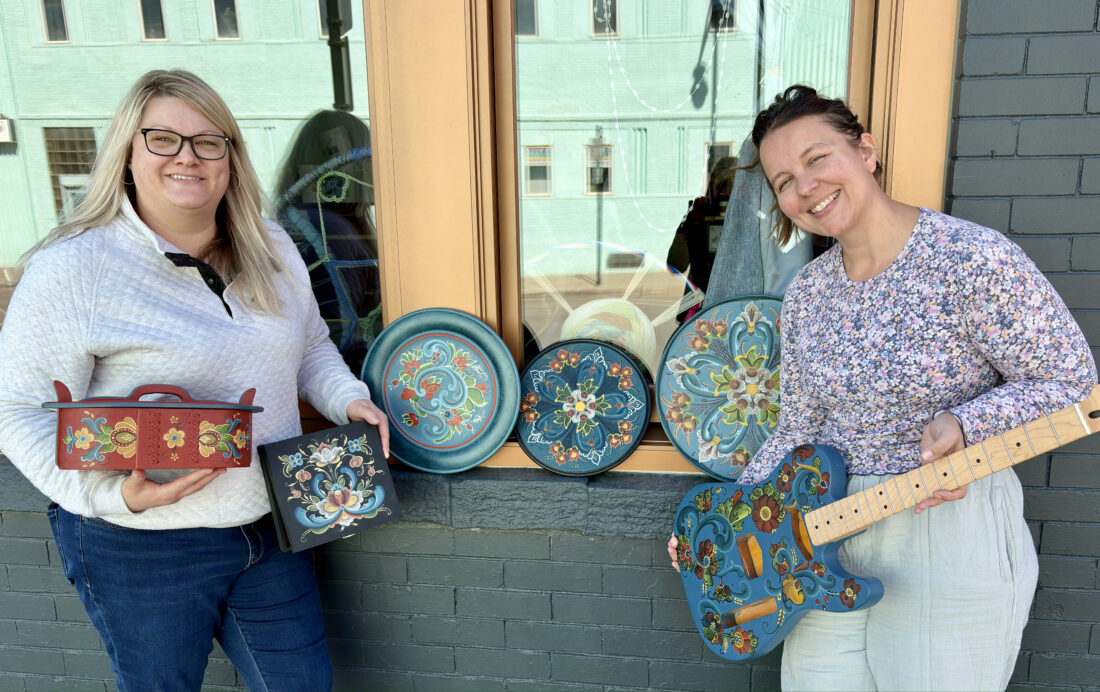Keeping cultural traditions alive: Local women preserve heritage with artist’s brush

Jill Schramm/MDN Jennifer Lock, left, and Jazmine Schultz, right, display some of their rosemaled items Sunday, Sept. 7. Lock painted the boxes and nearby plate, and Schultz painted the two plates of the same design and the guitar.
An elaborate, beautiful painting style that dates to the mid-1700s, Norwegian rosemaling might be a lost art but for the community of enthusiasts who keep the art form alive.
Rosemaling expert Joan Varty has contributed to preserving the art in traveling around the region to teach others interested in Norwegian culture.
“It’s really important to me, too, that this tradition continues, and you don’t have to be Norwegian to want to do this. You just have to be traditional about the way you want to do it, and that’s what I teach them,” Varty said.
Traditional rosemaling follows patterns and designs that are specific and indicative of certain communities in Norway.
Along with the classes she teaches, Varty has worked with two Minot apprentices through a North Dakota Council on the Arts grant program.
Jazmine Schultz said she approached Varty about participating in the apprenticeship program after taking community education classes with her for several years. Her interest in rosemaling stemmed from visits with her grandmother to Norsk Hostfest every year. Although her family really didn’t strongly identify with their Norwegian heritage, she found herself drawn to rosemaling.
“There’s something about folk art that just interests me,” she said. “Folk art just is interesting and cool because it’s passed down from generation to generation. And rosemaling is particularly cool because it has just morphed, depending on which community gets a hold of it.”
Schultz said pursuing the apprenticeship program was a way to make a commitment that she could stick to in her busy schedule, but she also had a project in mind. She rosemaled a design on a wood guitar, which she eventually hopes to cover with a finish and add strings so it can be played.
Schultz participated in the apprenticeship two years ago. Jennifer Lock of Minot learned about the program through Schultz and participated this past year.
“My interest started when I was younger, seeing pieces in my grandma’s house, and like Jazmine, I’ve gone to the Hostfest forever, and seeing it there, too, you just kind of start connecting all the dots,” she said. “Then, I’m kind of a creative, artsy kind of person, too, and I just loved it.”
She took her first class from Varty about nine years ago and has continued to study the art form since.
Through their apprenticeships, Schultz and Lock were able to explore several different styles of rosemaling. Traditional rosemaling uses oil paints, which have long drying times. Schultz and Lock considered that an advantage in redoing or retouching aspects of a design but noted it poses challenges as well.
For instance, the difficulty in finding an appropriate finish material for her oil paint design is the reason her rosemaled guitar piece remains a work in progress, Schultz said.
“The one thing I’ve learned is painting is just the appreciation of time,” Lock said. “You have to take the time to be good at it and learn and develop skill. It’s just funny to me how much time it takes, just with everything – painting, letting it dry, just taking it all in.”
Lock and Schultz said Varty had the ability to identify techniques they are good at and direct them to rosemaling styles that best fit their skills.
At the end of the yearlong program, Lock displayed her rosemailing at a reception at the Taube Art Museum in Minot. Schultz had held her reception at her bakery, Prairie Sky Breads.
The exposure to rosemaling created by the apprenticeship program has resulted in more people signing up for classes that she teaches, Varty said.
“It was a good way to get the word out. It’s been very successful,” she said.
Varty is a member of Nordland Rosemaling Association, based in Grand Forks, which hosts workshops with gold medalists from the annual National Norwegian-American Folk Art Exhibition in Decorah, Iowa. She said she attends rosemaling classes twice a year hosted through the association “just to make sure I am doing it right and learning new ways.”
Varty will be conducting rosemaling demonstrations each day at Norsk Hostfest as part of artisan presentations at the top of every hour. The Lag and Laere (make and learn) sessions will take place in Copenhagen Hall.
Hostfest visitors who purchase clogs at the clog shop also can have Varty rosemale on the shoes.
Schultz and Lock said rosemalers are a special community. Those friendships are one of the reasons she continues to take classes, Schultz said.
Lock attended a rosemaling convention in Minneapolis in June, meeting people of all ages from across the United States. She was impressed with how widespread the folk art is, although given the number of people who have never heard of rosemaling, she believes there’s room to make the art even better known.
In their efforts to establish relevancy in modern society, Schultz and Lock are incorporating the tradition in its historical accuracy into nontraditional objects. Schultz has painted on musical instruments and jewelry, while Lock has rosemaled keychains and the tops of cupcake picks. They follow safety protocols for oil-painted objects worn or used near food.
“It’s interesting to be doing something that someone so long ago was doing. There’s something cool about that,” Schultz added. “That’s sort of what’s appealing to me about this, also – how to give it staying power in this time.”




